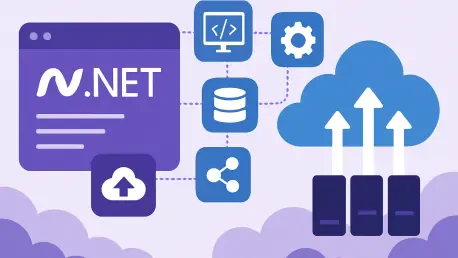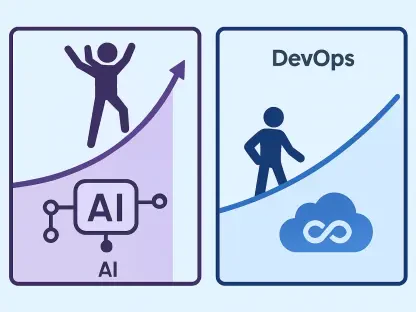Imagine a world where building complex, distributed cloud-native applications feels as intuitive as crafting a simple desktop app, with tools that anticipate developer needs and streamline every step of the process. This vision is becoming a reality with the latest release of .NET Aspire 9.5, a framework update from Microsoft that promises to redefine how developers approach distributed systems. Unveiled recently, this version introduces an array of features aimed at simplifying workflows, enhancing visibility, and integrating cutting-edge technologies. From innovative file-based application support to AI-driven debugging tools, the update addresses key challenges faced by developers in managing intricate cloud-native projects. This release signals a strong push toward making development environments more accessible and efficient, catering to both seasoned professionals and newcomers navigating the complexities of distributed architectures.
Enhancing Developer Experience with Innovative Tools
Streamlining Project Setup with File-Based Support
A significant highlight of .NET Aspire 9.5 is the preview of file-based AppHost support, designed to align with the upcoming .NET 10 release expected later this year. This feature enables developers to define an entire distributed application within a single apphost.cs file, removing the burden of managing traditional project files and multiple associated components. By leveraging .NET 10’s single-file application capabilities, setup complexity is drastically reduced, allowing for a smoother onboarding process. This experimental feature, currently accessible behind a feature flag and requiring the .NET SDK 10.0.100 RC1 or later, showcases a deliberate strategy to test and refine innovative approaches before a broader rollout. Such simplification is poised to lower entry barriers for developers tackling distributed systems, making it easier to focus on coding rather than configuration.
Beyond the initial setup, this file-based approach fosters a more cohesive development experience by centralizing application definitions. Developers can now navigate and modify their projects with greater ease, as the elimination of scattered files reduces the risk of errors and misconfigurations. This update also reflects an understanding of the need for agility in modern development cycles, where time-to-deployment is often a critical factor. By minimizing setup overhead, .NET Aspire 9.5 empowers teams to iterate quickly and adapt to changing requirements without getting bogged down by structural complexities. This forward-thinking design choice underscores a commitment to enhancing productivity at every stage of the development journey.
AI-Driven Insights through GenAI Visualizer
Another groundbreaking addition is the GenAI visualizer, seamlessly integrated into the Aspire Dashboard to provide AI-driven insights. This tool aggregates and displays interactions with large language models (LLMs) used within applications, presenting prompts, responses, and even generated images through an intuitive interface. Accessible via a distinctive sparkle icon, the visualizer offers developers a clear window into how their applications engage with advanced AI components. This capability not only aids in debugging but also enhances monitoring by shedding light on AI behavior, a critical aspect as more applications incorporate machine learning and natural language processing elements.
The inclusion of such a tool highlights a broader industry trend toward embedding AI capabilities directly into development environments. By offering real-time visibility into LLM interactions, the GenAI visualizer equips developers with actionable data to fine-tune application performance and troubleshoot issues efficiently. This feature also serves as a bridge between traditional coding practices and emerging AI technologies, ensuring that developers can harness powerful models without needing specialized expertise. As cloud-native applications increasingly rely on AI, tools like this visualizer become indispensable for maintaining control and optimizing outcomes in complex systems.
Boosting Performance and Connectivity
Optimizing Workflows with CLI and Dashboard Enhancements
Performance optimization takes center stage in .NET Aspire 9.5 with a series of updates to the command-line interface (CLI) and Aspire Dashboard. Enhancements such as faster package resolution, a disk cache for package searches, cleaner debug output, and clearer status messages address longstanding pain points in development workflows. Additionally, the introduction of an “All” option in console logs, which streams logs from all running resources with color-coded prefixes, enables developers to monitor activities across multiple services simultaneously. These refinements collectively ensure quicker setup times and more efficient maintenance, allowing focus to remain on innovation rather than troubleshooting.
Further bolstering usability, the new aspire update command automates the process of upgrading the AppHost SDK and integrations, simplifying version management. Meanwhile, dashboard improvements make it a more robust tool for debugging and monitoring distributed systems, providing a centralized hub for critical insights. These updates demonstrate a keen awareness of the need for seamless tools in managing the intricacies of cloud-native applications. By reducing friction in everyday tasks, these enhancements enable developers to allocate more time to creative problem-solving and less to administrative overhead.
Strengthening Collaboration with Azure Dev Tunnels and APIs
Connectivity and collaboration receive a significant boost with the inclusion of support for Azure Dev Tunnels in .NET Aspire 9.5. This feature allows developers to securely share local web services over the internet, facilitating remote teamwork and testing without compromising security. Alongside this, new resource lifecycle event APIs offer greater control during application shutdown by enabling the registration of callbacks for resource cleanup and coordination. Such capabilities ensure smoother transitions and better resource management, critical for maintaining stability in distributed environments.
Complementing these features, targeted CLI updates like channel-aware package selection provide flexibility in choosing between stable, daily, or custom builds, catering to a variety of development scenarios. These tools collectively foster an ecosystem where collaboration and precision go hand in hand, addressing the diverse needs of modern development teams. By prioritizing secure sharing and meticulous resource handling, this release lays a foundation for more cohesive and reliable distributed application development, ensuring that teams can work effectively regardless of geographic or technical constraints.
Reflecting on a Step Forward
Looking back, the rollout of .NET Aspire 9.5 marked a pivotal moment in the evolution of cloud-native application development. The preview of file-based AppHost support, paired with the GenAI visualizer, showcased a dedication to simplifying complex processes while embracing cutting-edge AI tools. Performance optimizations, seamless integrations like AddOpenAI, and connectivity enhancements through Azure Dev Tunnels and resource APIs addressed a wide array of developer challenges. Moving forward, exploring how these features can be leveraged to tackle specific project demands is essential. Consider integrating these tools into existing workflows to streamline operations, or experiment with the experimental features to stay ahead of the curve. As the landscape of distributed systems continues to evolve, staying engaged with such advancements will be key to building resilient, innovative applications that meet tomorrow’s needs.









